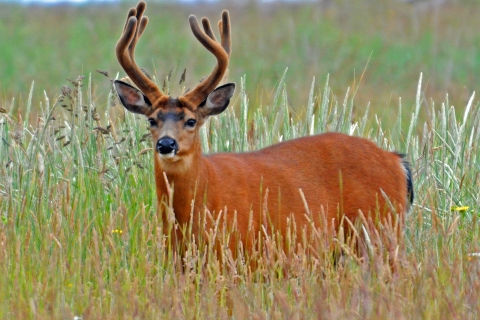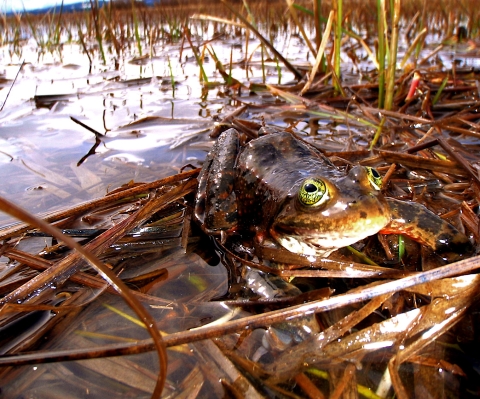Since time immemorial, Tribes in the Pacific Northwest have relied on plants and animals to sustain their way of life. In a sacred covenant, salmon, deer, roots and berries, and the very rivers that sustain them all gave of themselves so that people may live. In exchange, Tribal people carry a responsibility to protect and conserve those who gave of themselves.
The U.S. Fish and Wildlife Service’s Tribal Wildlife Grant program supports critical conservation projects on Tribal lands. The Service partners with Tribes to benefit plants, wildlife, and habitat of tribal cultural or traditional importance. Tribes have leveraged millions of dollars from the Tribal Wildlife Grant program to sustain and enhance fish and wildlife and advance tribal conservation priorities.
In 2023, six Tribes in Oregon, Washington, and Idaho received a total of more than $1.1 million for new and ongoing conservation projects. The summaries below share details of the selected proposals.
Oregon
Confederated Tribes of the Umatilla Indian Reservation: Mid-Columbia Freshwater Mussel eDNA Distribution Surveys
Freshwater mussels are a First Food of the Confederated Tribes of the Umatilla Indian Reservation (CTUIR) and harvest of them remains a reserved right for members. Until the early 1900s, Tribe members consumed freshwater mussels primarily during winter months and used the shell material for tools and ornamentation. Because mussel populations are so depleted, harvest is not currently possible in most traditional use areas.
The Tribe will use 2023 Tribal Wildlife Grant funds to support the Freshwater Mussel Research and Restoration Project, which was started in 2002 with a goal of restoring self-sustaining mussel populations to areas traditionally used in the mid-Columbia basin. This study will collect environmental DNA samples and complete snorkel surveys to determine the distribution and abundance of the Western Ridged Mussel and presence of other mussels in ceded areas of the CTUIR and the Yakama Nation. It supports research, restoration, and collaboration with partners to monitor, conserve and restore mussel populations throughout the Tribes’ ceded territory.
Washington
Makah Tribe: Evaluating Sampling Methods for Estimating Black-tailed Deer Populations, Selecting Long-term Monitoring Strategies, and Providing Science-driven Management Recommendations
The Makah Tribe is dependent on black-tailed deer to help meet cultural and subsistence needs within the community. Black-tailed deer populations have been challenging to estimate accurately because of the dense cover in coastal temperate rainforests. Researchers have been developing and refining more accurate and cost-effective methods to collect and analyze data on black-tailed deer populations, including non-invasive camera trapping and fecal DNA capture-recapture population modelling.
The Makah Tribe will estimate deer home ranges and habitat use and observe interactions among adult deer and cougars and compare several methods to estimate black-tailed deer abundance and determine the best long-term monitoring strategies for this species. Results from the proposed project will increase the Tribe’s capacity to determine impacts of predation, hunting, and land management activities on deer populations to better inform management recommendations and educate the community.
Kalispel Indian Community of the Kalispel Reservation: Kalispel Tribe Waterfowl Project
Waterfowl are an important cultural species to the Kalispel Tribe. Unfortunately, little is known about population dynamics in the northeast section of Washington state within the Pacific Flyway.
The Kalispel Tribe will use grant funds to initiate a waterfowl banding program and help evaluate waterfowl use of tribally owned properties as well as wetland use throughout the flyway. This project will increase the number of mallards banded for the Western Mallard Model -- which is used to determine hunting seasons and bag limits -- and will place tracking devices on other species. This information will inform future restoration projects intended to improve waterfowl productivity, increase populations, and improve harvest management.
Shoalwater Bay Indian Tribe of the Shoalwater Bay Indian Reservation: Western Snowy Plover and Streaked Horned Lark Habitat Management Plan
The Shoalwater Bay Indian Tribe’s coastal beaches and dunes are one of only three sites in Washington that provide nesting and fledgling habitat for streaked horned larks and western snowy plovers. The Tribe will use these funds to improve the conservation status of these birds by removing non-native species, replanting traditional plants and restoring key habitats. These actions will increase the resilience of coastal dune and shoreline habitats to withstand erosion and flooding and increase shellfish and fish resources. Habitat improvements for plovers and larks will also benefit Tribal members by restoring land and increasing the availability of traditional plants, shellfish, and fish resources for Tribal members.
Samish Indian Nation: Oregon Spotted Frog Habitat Study
The Oregon spotted frog is a species of cultural importance to the Samish Indian Nation. The frog's habitat also provides a healthy environment for other culturally significant and traditional use plant and animal species.
The Samish Indian Nation’s project continues five years of Oregon spotted frog monitoring at a breeding site on the Samish River in Skagit County, Washington. Funds will be used to manage habitat, including removing non-native species, monitoring frog population and egg predation, and developing outreach materials. The project activities and collaboration with project partners are expected to make a substantial and positive impact on Oregon spotted frog populations within the Samish River watershed.
Idaho
Coeur d'Alene Tribe: Waterfowl Management on the Coeur d'Alene Reservation
The Coeur d'Alene Tribe has hunted, gathered and lived along the waterways of northern Idaho, eastern Washington and western Montana since time immemorial. These waters provide key migration and breeding habitat for a variety of waterfowl species. Waterfowl populations in this region face a suite of habitat-related threats such as the reduction in wetlands from agricultural practices, development around the shoreline of Lake Coeur d'Alene, and heavy metal laden sediments in the Coeur d'Alene River floodplain.
The Coeur d’Alene Tribe will use grant funding to increase its role in regional waterfowl monitoring projects, including bird banding, purchasing additional equipment and training, and data collection. Project data will lead to the development of a management plan that will guide restoration actions to improve waterfowl habitat and productivity on Tribal lands.








